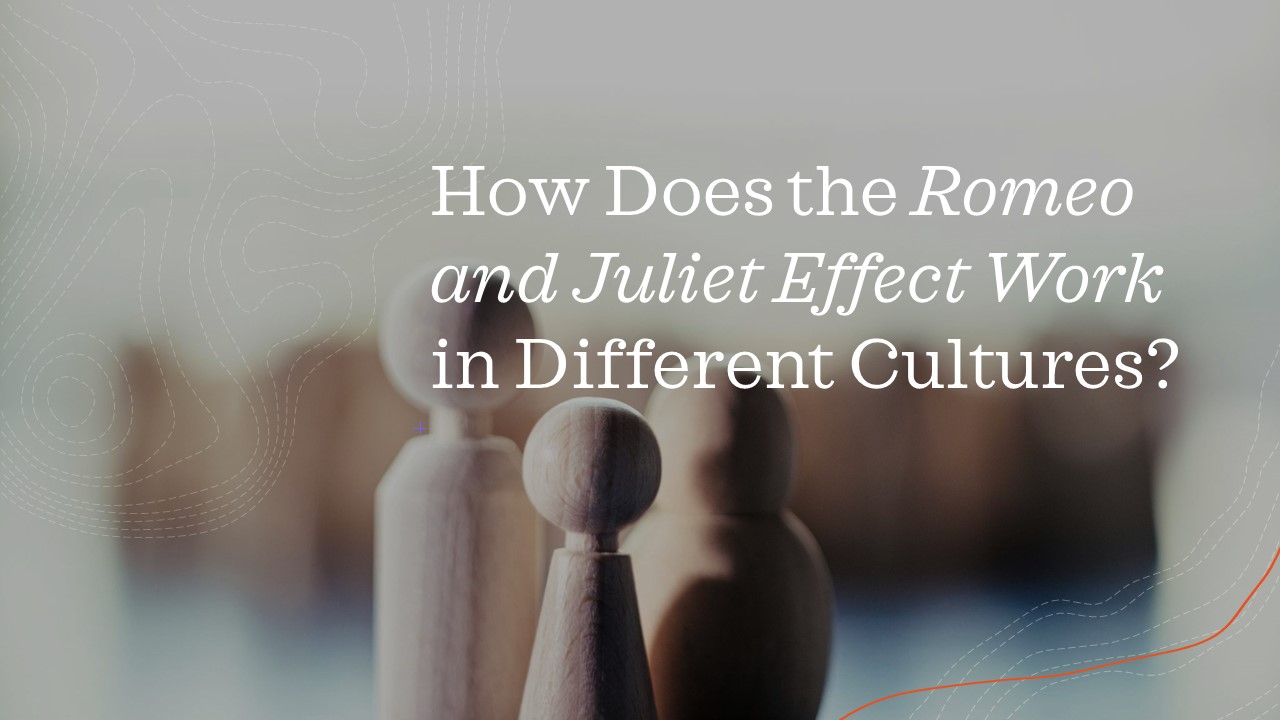Authors: Victor Karandashev and Ernest Light
Young women and men may believe that they are free to fall in love, and romantic partners who they choose are their individual choice. However, their family members and networks of friends can still significantly influence their romantic preferences.
What Is the Romeo and Juliet Effect?
In the 1970s, American researchers investigated the effect of family on romantic love feelings (Driscoll et al., 1972). They discovered that parental disapproval of a romantic relationship can lead to the opposite effect: increased feelings of attraction and love between the partners. The effect discovered in the study mirrored the story of Romeo and Juliet, where their families’ feud intensified their love despite the opposition. Basically, the more forbidden the relationship seems, the stronger the desire to pursue it can become. So, the authors called this psychological phenomenon the “Romeo and Juliet effect.”
The Romeo and Juliet Effect on romantic love feelings was referred to as fact for many years following this study (Driscoll et al., 1972). We reviewed the Romeo and Juliet effect in another article. Does this effect really work? Let us look at a few other studies.
The Romeo and Juliet Effect Revisited
However, other scientific studies conducted years later yielded different outcomes inconsistent with previous findings (Felmlee, 2001; Parks et al., 1983; Sprecher, 2011; Sprecher & Felmlee, 1992). The findings indicated that anticipated support from an individual’s own family and friends significantly influenced relationship quality, surpassing the impact of expected support from a partner’s family and friends.
However, as we demonstrated, these results did not support the Romeo and Juliet effect. Many other studies have discovered a reverse effect of one’s social network, in which disapproval of the social network—parents and friends—leads to a decline in the quality of romantic relationships (Felmlee, 2001; Sinclair et al., 2015).
The Romeo and Juliet Effect May Have a Culturally Different Effect
It is reasonable to assume that the absence of the Romeo and Juliet effect may be attributed to the fact that other researchers conducted their studies 40 years subsequent to the identification of this phenomenon. During this period, American society has substantially changed. Modern cultures may have evolved to such an extent that the impact of family has flattened out and become more difficult to observe.
In addition, individualistic and collectivistic cultures differ greatly in the value they place on individuals’ independence and dependence on the influence of family and others in a social network, who significantly affect their attitudes, preferences, emotions, and actions in love relationships (Karandashev, 2017; 2019; 2021).
Actually, the majority of the research on the Romeo and Juliet effect has come from individualistic cultures, like the US, where people generally believe that they have a lot of leeway to choose their romantic partners (Karandashev, 2019). Individuals in collectivistic societies are more likely to take their family’s opinion into consideration, while those in individualistic societies are more likely to fight against it.
For example, in research conducted on cross-cultural samples of participants from the Netherlands, Kurdistan, Iraq, and Canada, as well as numerous students from other countries studying in the Netherlands and Canadian students with Southeastern roots (Buunk, Park, & Duncan, 2010), it has been shown that family influence on love choices is predominant in cultures with a high degree of collectivism. In individualistic societies, family influence is much weaker.
References
Buunk, A. P., Park, J. H., & Duncan, L. A. (2010). Cultural variation in parental influence on mate choice. Cross-Cultural Research, 44(1), 23-40.
Driscoll, R., Davis, K. E., & Lipetz, M. E. (1972). Parental interference and romantic love: The Romeo and Juliet effect. Journal of Personality and Social Psychology, 24, 1–10.
Felmlee, D. H. (2001). No couple is an island: A social network perspective on dyadic stability. Social Forces, 79(4), 1259-1287.
Karandashev V. (2017) Romantic Love in Cultural Contexts. Springer.
Karandashev V. (2019) Cross-Cultural Perspectives on the Experience and Expression of Love. Springer.
Karandashev V. (2021) Cultural Models of Emotions. Springer Nature.
Parks, M. R., Stan, C. M., & Eggert, L. L. (1983). Romantic involvement and social network involvement. Social Psychology Quarterly, 46, 116-131.
Sinclair, H. C., Hood, K. B., & Wright, B. L. (2014). Revisiting the Romeo and Juliet effect (Driscoll, Davis, & Lipetz, 1972): Reexamining the links between social network opinions and romantic relationship outcomes. Social Psychology, 45(3), 170–178.
Sinclair, H. C., Felmlee, D., Sprecher, S., & Wright, B. L. (2015). Don’t tell me who I can’t love: A multimethod investigation of social network and reactance effects on romantic relationships. Social Psychology Quarterly, 78(1), 77-99.
Sprecher, S. (2011). The influence of social networks on romantic relationships: Through the lens of the social network. Personal Relationships, 18(4), 630-644. Sprecher S., Felmlee D. (1992). The Influence of Parents and Friends on the Quality and Stability of Romantic Relationships: A Three-Wave Longitudinal Investigation. Journal of Marriage and the Family,54, (4), 888—900.
